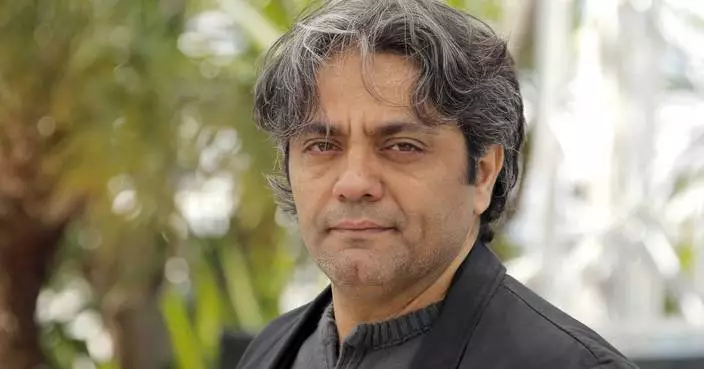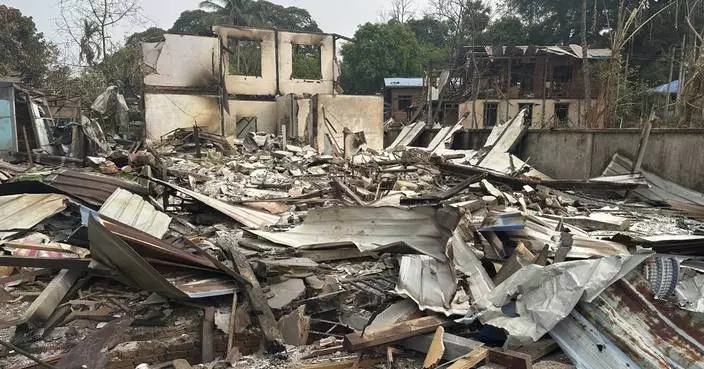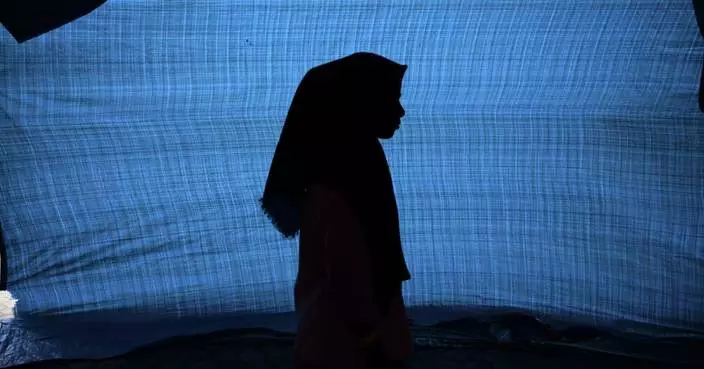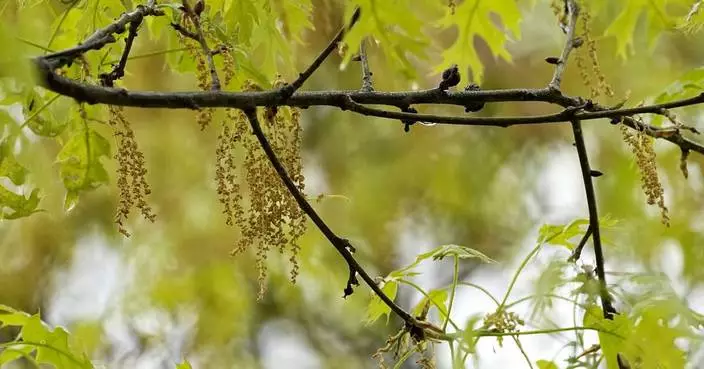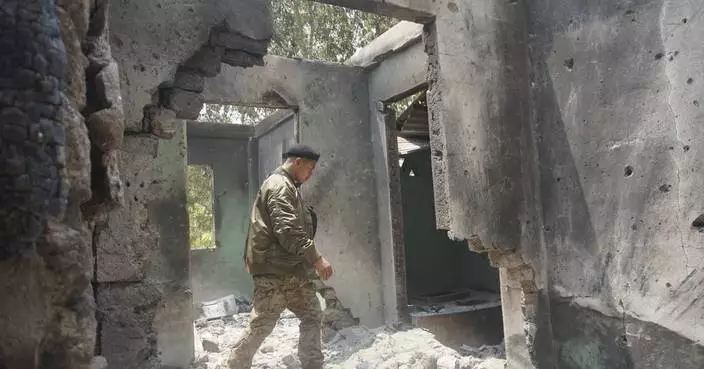An information blackout under Myanmar's military junta worsened Thursday as fiber broadband service, the last legal way for ordinary people to access the internet, became intermittently inaccessible on several networks.
Authorities in some areas have also begun confiscating satellite dishes used to access international news broadcasts.
Protests against the the Feb. 1 coup that ousted the elected government of Aung San Suu Kyi continued Thursday despite the killing of 11 people by security forces a day earlier.
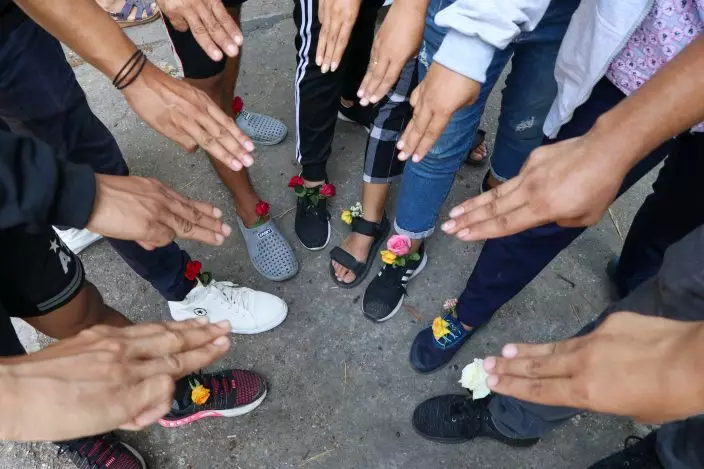
Anti-coup protesters show a three-fingered symbol of resistance with flowers in their shoes as they gather at Kamayut township in Yangon, Myanmar Thursday, April 8, 2021. They walked through the markets and streets of Kamayut township with slogans to show their disaffection for military coup. (AP Photo)
It was unclear if the internet interruptions for at least two service providers, MBT and Infinite Networks, were temporary. MBT said its service was halted by a break in the line between Yangon and Mandalay, the country’s two biggest cities, but internet users had been complaining for the past week of major slowdowns in the services.
The junta has gradually throttled internet service since the coup. It initially imposed a largely ineffective block of social media such as Facebook and then cut mobile data service, the most common way of connecting to the internet, but only at night. As the junta increased its use of deadly force against protesters it also imposed a total ban on mobile data use.
At least 598 protesters and bystanders have been killed by security forces since the takeover, according to the Assistance Association for Political Prisoners, which monitors casualties and arrests.
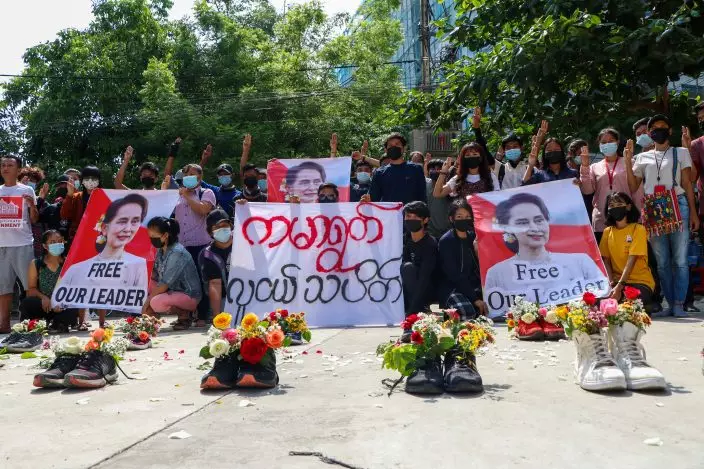
Anti-coup protesters gather at Kamayut township in Yangon, Myanmar Thursday, April 8, 2021, with shoes willed with flowers. They walked through the markets and streets of Kamayut township with slogans to show their disaffection for military coup. A sign, center, reads " Kamayut Youth Strike." (AP Photo)
The use of satellite television as a source of information also appeared to be under threat. In Laputta and other towns in the Irrawaddy Delta southwest of Yangon, local government vehicles announced over loudspeakers that it was no longer legal to use satellite dishes and they must be turned in at police stations. Police also raided shops selling the dishes and confiscated them.
Online news services Khit Thit Media and Mizzima said similar measures were taken in Mon state in the country’s southeast. Satellite TV offers access to international sources of news about Myanmar.
Since the coup, all non state-owned daily newspapers have stopped publishing and online news sites have come under severe pressure. Five popular independent news services had their operating licenses revoked in early March and were told to stop publishing and broadcasting on all platforms, but mostly defied the orders. Other agencies have been sued over their coverage.

Anti-coup protesters walk through a market with images of ousted Myanmar leader Aung San Suu Kyi at Kamayut township in Yangon, Myanmar Thursday, April 8, 2021. They walked through the markets and streets of Kamayut township with slogans to show their disaffection for military coup. (AP Photo)
About 30 journalists arrested since the coup remain detained. Roughly half of them have been charged with violating a law covering circulation of information that could hurt national security or disturb public order. The offense is punishable by up to three years in prison.
In an open letter on Tuesday to Myanmar’s military government, the New York-based Committee to Protect Journalists called for “the immediate and unconditional release of all journalists detained in the aftermath of your February 1 suspension of democracy and imposition of emergency rule.”
The group said that since the military’s takeover, “press freedom conditions have rapidly and drastically deteriorated in your country. News reports indicate journalists have been beaten, shot and injured by live bullets and arbitrarily arrested and charged by security forces while merely doing their jobs of covering the demonstrations and your regime’s retaliatory clampdown.”
Thursday’s protests included ones in Launglone township, in the south of the country, where villagers sang songs and lit candles before dawn and then marched down rural roads, and in the city of Dawei, also in the south, where engineers, teachers, students and others joined in their latest demonstration.
Despite eight killings in Dawei by security forces, opponents of the junta have continued to protest on the streets, avoiding confrontations by varying the starting times and breaking into smaller groups.
On Wednesday, security forces stormed the town of Kalay in northwestern Myanmar where some residents had used homemade hunting rifles to form a self-defense force. Security forces killed at least 11 civilians and injured many others, local news reports said. The state-owned Global New Light of Myanmar newspaper reported Thursday that 18 people described as rioters with homemade weapons had been arrested but said nothing about civilian casualties.
BANGKOK (AP) — Reports that soldiers of Myanmar’s military government last week carried out a massacre of more than 30 civilians in a village in central Myanmar were supported Monday in interviews with a local administrator and a man who says he survived the killings.
The bloodshed on Saturday morning in Let Htoke Taw village in Sagaing region’s Myinmu township, reported by independent media, was the latest of three mass killings in the past few days in Myanmar’s brutal civil war.
The Associated Press couldn’t independently verify details of what happened, and the military government didn’t immediately respond to an emailed request for comment. It has denied past accusations of attacks on civilians and in some cases placed the blame on resistance forces.
Myanmar has been mired in violence since the military’s February 2021 seizure of power from the elected government of Aung San Suu Kyi prompted nationwide peaceful protests that security forces suppressed with deadly force. The violent repression triggered widespread armed resistance, which has since reached the intensity of a civil war.
The other two recent mass killings involved at least 15 people from a resistance group, along with civilians, who were killed in an airstrike while holding a meeting at a monastery in central Magway region on Thursday, and 32 people killed that same day in disputed circumstances in fighting in Mandalay region, also in the central part of the country.
Thirty-three people, including three 17-year-old boys, two older people and three carpenters from a nearby village, were killed Saturday in an army raid on Let Htoke Taw, said a local administrator loyal to the opposition National Unity Government who managed to escape from the village.
The National Unity Government, the country’s main opposition group, operates as a shadow government and stakes a claim to greater legitimacy than the ruling military.
The administrator, who spoke to the AP on condition of anonymity because he feared for his personal safety, said that at least 11 other villagers were wounded when 100-200 soldiers and armed men believed to be members of an army-affiliated militia entered the village in an apparent search for resistance fighters of the Peoples Defense Force, the loosely organized armed wing of the National Unity Government.
A Let Htoke Taw villager told the AP on Monday that panicked residents sought to flee when the soldiers, firing their weapons, attacked shortly after 5 a.m., and those who couldn't escape the village sought safety in the main building of the local Buddhist monastery.
The 32-year-old villager, also insisting on anonymity for safety’s sake, said that he, his wife and two children and other family members ended up at the monastery, but were held captive in the main building there by the soldiers along with about 100 other villagers.
He said that he and more than 30 other men were brought outside by the soldiers and forced to sit in rows on the ground while they were interrogated with questions about who the local resistance leaders were and where they could be found.
Despite beatings, the men in the front row denied knowing such information, and then the soldiers began shooting them, initially one by one, and then en masse, the villager said.
The villager said that he slumped onto the ground after a man sitting beside him who was shot multiple times fell on top of him. He said he could hear the firing continue from several weapons, and a captain ordering his men to shoot their victims until they were dead. There were 24 dead at the scene, and nine people killed elsewhere in the village, he said. Photos provided to the AP show about that number of corpses, several with wounds visible, laid out in two-and-a-half rows.
The survivor, who was wounded in the left armpit, said that he played dead for a half-hour until the soldiers left the monastery compound around 7 a.m., after burning the bodies of five dead men and taking hostage 17 villagers including his wife and children. The hostages were released outside the village, he said.
Both he and the administrator said that soldiers burned down between 170 and 200 homes in the village, a tactic it has been accused of repeatedly employing. They also said the soldiers destroyed the village's water pumps.
Sagaing has been a stronghold of armed resistance to the army, which has responded with major offensives using ground troops supported by artillery and airstrikes, burning down villages and driving hundreds of thousands of people from their homes.
Let Htoke Taw village, which is located about 70 kilometers (45 miles) west of Mandalay, the country’s second-largest city, has been previously targeted by soldiers fighting the resistance, and about 545 houses there were set on fire in May last year.

This UGC photo provided by the People’s Defense Force shows bodies of the victims allegedly killed by soldiers of Myanmar’s military government are laid out before being buried at the burial ground outside of Let Htoke Taw village in Sagaing region’s Myinmu township, Myanmar, Saturday, May 11, 2024. Reports that soldiers of Myanmar’s military government last week carried out a massacre of more than 30 civilians in a village in central Myanmar were supported Monday in interviews with a local administrator and a man who claims to have survived the killings. (People’s Defense Force via AP)

This UGC photo provided by the People’s Defense Force shows a truck transporting bodies of victims allegedly killed by soldiers of Myanmar’s military government, to be buried outside of Let Htoke Taw village in Sagaing region’s Myinmu township, Myanmar, Saturday, May 11, 2024. Reports that soldiers of Myanmar’s military government last week carried out a massacre of more than 30 civilians in a village in central Myanmar were supported Monday in interviews with a local administrator and a man who claims to have survived the killings. (People’s Defense Force via AP)








